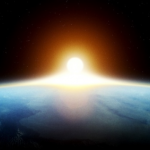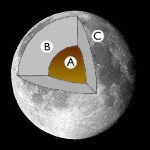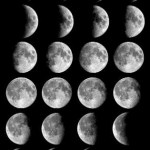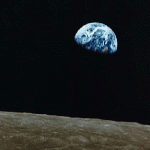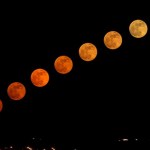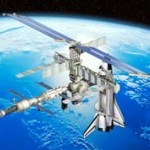Earth
Something happened in Siberia 100 years ago - exactly, on this day. I always found the event very intriguing. If you want to learn everything one needs and wants to know about the event, written in a way that will make you excited - go and read Archy's latest masterpiece (hmmm, anthology-worthy?).
There is a huge forest fire raging in Eastern North Carolina, unfortunately affecting the Pocosin Lakes National Wildlife Refuge. The smoke has now moved more than 100 miles to the west, which means right here. It's been stinking of smoke all day, getting worse and worse as time went on. And it appears it will not get any better soon.
Let's say we're having a nice day here on Earth; the Sun is shining, the clouds are sparse, and everything is just looking like a peach:
And then Lucas goes and tells me,
Oh my God, Ethan! It's Armageddon! An asteroid is coming straight for us! You've got to stop it!
Really? Me? Well, how would I do it? Let's say we've got some reasonably good asteroid tracking going on, and we've got about 2 months before the asteroid is actually going to hit us. We'd like to do something with the situation on the left, to avoid the situation on the right:
Well, what we really have to do is change the…
But I didn't want one! Stop your whining, Earthlings. We have a serious question to answer, courtesy of Tamara:
What’s the moon like below its surface, moving into the interior? And what’s the current thought on its formation?
Well, we do know a lot about the Moon's insides the same way we know about the Earth's; just like the Earth has earthquakes, the Moon has moonquakes. These tell us about the Moon's interior. From back when we landed on the Moon, we planted the Apollo seismic experiments and saw 28 moonquakes. From these, we learned that the Moon has a crust about 60 km deep, a deep…
And if the band you're in starts playing different tunes
I'll see you on the dark side of the Moon.
One of my favorite readers, Zrinka, asks us why we're only able to see one side of the Moon from Earth. Seriously, look at the different phases; we always see the same side of the Moon:
How does this happen? Well, the Moon makes one revolution around the Earth about every 29 days, and that's what causes the Moon phases. But the Moon also rotates once every 29 days also. Because of this, the same side of the Moon always faces the Earth:
We call this "being locked." We're not the only system…
There were quite a lot of events and actions in Belgrade for the Earth Day last week. I came in on that day so I did not have time to see anything. But I loved the balloon they placed in the center of the Slavija square: it was a globe with recognizable outlines of the continents. But the parts of the world were labeled with the names of main streets, parts and neighborhoods of Belgrade (with some effort to match "characters" of the places):
The balloon was supposed to be set free on Earth Day, but, just as I was speaking at the Pediatric Center, a huge storm started outside and broke…
Since the dawn of time man has yearned to destroy the sun. - C. M. Burns
There's no need to stop at the Sun, though. Since yesterday was Earth day, I thought it was only appropriate to spend today telling you how not only to destroy the Earth, but to effectively destroy the entire Universe. To tell you this story, we have to go all the way back to the beginning, to just before the big bang.
The big bang was when the Universe was hot, dense, full of energy, and expanding very quickly. The Universe was also spatially flat and the same temperature everywhere, and full of both matter and…
As you may have noticed from yesterday's unusual post, today is Earth Day! I thought I'd share with you some of my favorite pictures from space of it, including the famous photograph from Apollo 8 known as Earthrise:
This combination shot made from NASA’s Terra satellite and NOAA’s Geostationary Operational Environmental Satellite:
The known satellites at least 0.1 meters in size in orbit around Earth (there are ~11,000 of them as of April 2005, and another 100,000 between 1 cm and 10 cm in size):
Looking at the Earth and the docked Space Shuttle from the International Space Station:
And…
What makes earthquakes? Although there are many causes, including volcanoes, the most common thing that causes them are tectonic motions, which also cause tsunamis. But as valuable as it is to understand other planets in our solar system and in other star systems, sometimes it's important to understand what's going on inside our own planet.
The crust of the Earth actually is made up of a number of plates, which rub against one another and move over time. Who's to blame? I fault the liquid hot magma.
So what happens is that these plates slip against each other in one of three ways, as shown…
Fraser Cain over at Universe Today sent out a question to the Astronomy/Astrophysics/Space communication community today. And he asks:
Why should we spend our time/money/resources on exploring space when there are so many problems here on Earth?
This is something that, for better or worse, I had a knee-jerk reaction to. Here's what I wrote back to him:
This is like asking why we should spend money on making our city better when there are so many problems here in our own homes. Or why we should spend money on understanding our whole world when there are so many problems here in our own…
Though, at some times and places in history, February 24th was considered to be the Leap Day. For the more science-oriented folks, Phil Plait explains why we have leap days.
I was thinking about the timeline that brought us here, today, from the origin of the Universe up through the present day. I realized that the most uncertain thing that we know of, the step that we have the least information about, is the origin of life on Earth. All hypotheses about how life on Earth originated fall into three categories:
Abiogenesis, or the idea that life came from non-life, somehow, on Earth.
Life originated elsewhere in the Universe, and was brought to Earth, where it now thrives (e.g., panspermia, or exogenesis).
Life was created or designed by an outside force/being…
There is a lot of stuff one hears about food, sustainability, environment, etc., and it is sometimes hard to figure out what is true and what is not, what is based on science and what is emotion-based mythology.
For instance, some things I have heard over the years and have no means to evaluate if they are even close to plausible:
Claim #1: if we used every square inch of arable or potentially arable land, clearing the rainforest, turning deserts into fields, removing cities, malls and highways, killing all the animals, destroying all natural ecosystems, moving all humans to the Moon and…
As Bonnie Tyler sang, and later The Dan Band (with more cursing),
Once upon a time there was light in my life
But now there's only love in the dark
Nothing I can say
A total eclipse of the heart
Well, it isn't the heart, but this Wednesday night, beginning at 10 PM Eastern Standard time (8 PM my time, and 4 AM Thursday morning for my European readers), there is a total lunar eclipse. One of the things that's neat about a lunar eclipse, as compared to a solar eclipse, is that you can see it from everywhere on Earth at once! If you watch it, you'll see a full moon begin to be obscured, followed…
The closest you're going to get from me on Valentine's Day is something red, dear readers. As the Moon is now a waxing gibbous and will be for the next week, it will brighten the sky for the majority of the night. But before sunrise, it will dip below the horizon and set. The funny thing is, if you've ever watched this (or watched a waning gibbous rise), you'll notice it changes color! In fact, this composite photo shows you what I'm talking about:
So the Moon, although white once it gets high up into the sky, appears yellow, orange, or even red when it's close to the horizon. I got a…
I've been talking about dark matter a lot, and yet there's still so much to explain about it. For example, dark matter and normal matter (protons, neutrons, and electrons) have a few things in common:
They both have mass.
They both feel the effects of gravity.
They both cause their own gravity.
But that's where the similarities end. I can make a long list of the ways that dark matter and gravity are different from one another, but I prefer to give you an example. Imagine the following scenario: you stand up from your seat, walk towards the wall, and smack right into it. You might wind…
Ever get sick of your life here on Earth? What about really getting away from it all; what if you wanted to live in space, orbiting the Earth, away from everyone. (At least for awhile, like a summer home.) What would you need to do it, and what would it consist of?
I propose an idea which I'll call a "space house," where I'll go through what I think is the cheapest and easiest way to get all the things you would need to comfortably survive in space for an extended period of time. First off, let's go over all the things a human would need to survive, while still having a good life, in space…
tags: earth, photography, subway art, AMNH, NYC, NYCLife
Journey to the center of the earth, view #3,
as portrayed in tiles on the walls of the NYC downtown subway platform (A-B-C)
at 81st and Central Park West. (ISO, no zoom, no flash).
Image: GrrlScientist 2008. [wallpaper size].
Read more about the AMNH tile artworks and see the AMNH tile artworks photographic archives -- with all the animals identified.
In our increasingly worldaround world, it is a rare, if not obsolete, occurrence for two wildly disparate and equally sophisticated cultures to meet for the first time. That's probably for the best, of course, because when it did happen in spades, during the centuries on Earth before instantaneous global communication, all bets were off, and what went down was almost always marked with catastrophe (as with the indigenous people of North America) or powderkeg-and-a-match mutual distrust (as with the first United States naval expeditions to Japan in the 1850s, a cultural collision that is…
The League of Conservation Voters has issued a comparison of all the Presidential candidates of both parties on the topic of conservation and global warming. Look at the Chart and watch the Video. Then decide.
